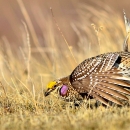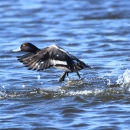About Us
Established in 1993, the District manages both U.S. Fish and Wildlife Service-owned waterfowl production areas as well as wetland and grassland easements on private lands in Stutsman and Wells counties.
Located in the famous Prairie Pothole Region, the most productive area for breeding waterfowl in North America, the District and surrounding area provide breeding and migratory habitat for more than 293 bird species.
The Prairie Pothole Region gets its name from the shallow freshwater wetlands (potholes) abundant across the Midwestern prairie landscape. This formerly glaciated landscape extends through part of eastern Montana, North Dakota, South Dakota, Minnesota, and Iowa in the United States. The Region also extends north into Canada.
There are two physiographic regions within the District, the Drift Prairie in the east and the Missouri Coteau in the west. Plants, wildlife, and habitat across these two areas are significantly different from one another. These areas were formed over 10,000 years ago by retreating glaciers.
Drift Prairie
The movement of glaciers along with the deposits of soil, rock, and minerals (drift) left behind, created the gently rolling topography seen throughout this area. Shallow depressions across the landscape became potholes and a wide variety of grasses and wildflowers became established across the uplands (prairie). Large expanses of grasslands have been tilled and small wetlands drained to accommodate many years of intensive farming of wheat, barley, corn, and beans throughout the Drift Prairie. The District focuses on protecting the fragments of grassland and wetlands that remain and restoring those that are no longer being farmed.
Missouri Coteau
The Missouri Coteau marks the western limits of glaciation in North Dakota and features more rugged and elevated terrain than the neighboring Drift Prairie. The area is dotted with wetlands, in some areas up to 100 per square mile. This intermixing of grasslands and wetlands is especially important for waterfowl breeding and nesting because many birds nest in the grasslands and raise their young in the wetlands. Land in this area is more likely to be used for cattle grazing than crop farming and large areas of grasslands and wetland remain intact.
Our Mission
Each unit of the National Wildlife Refuge System is established to serve a statutory purpose that targets the conservation of native species dependent on its lands and waters. All activities on those acres are reviewed for compatibility with this statutory purpose.
The mission of the National Wildlife Refuge System is to administer a national network of lands and waters for the conservation, management and, where appropriate, restoration of the fish, wildlife and plant resources and their habitats within the United States for the benefit of present and future generations of Americans.
The mission of the Chase Lake Wetland Management District is to protect wetlands and surrounding grasslands for waterfowl production and other wildlife.
Other Facilities in this Complex
Chase Lake Wetland Management District is part of the Eastern North Dakota Complex. A National Wildlife Refuge Complex is an administrative grouping of two or more refuges, wetland management districts or other refuge conservation areas that are primarily managed from a central office location. Districts and refuges are grouped into a complex structure structure
Something temporarily or permanently constructed, built, or placed; and constructed of natural or manufactured parts including, but not limited to, a building, shed, cabin, porch, bridge, walkway, stair steps, sign, landing, platform, dock, rack, fence, telecommunication device, antennae, fish cleaning table, satellite dish/mount, or well head.
Learn more about structure because they occur in a similar ecological region, such as a watershed or specific habitat type, and have a related purpose and management needs. Typically, a project leader or complex manager oversees the general management of all refuges within the complex and refuge managers are responsible for operations at specific refuges or wetland management districts. Support staff may include administrative personnel, law enforcement, refuge manager, biological, and fire staff that are centrally located and support all stations within the complex.








